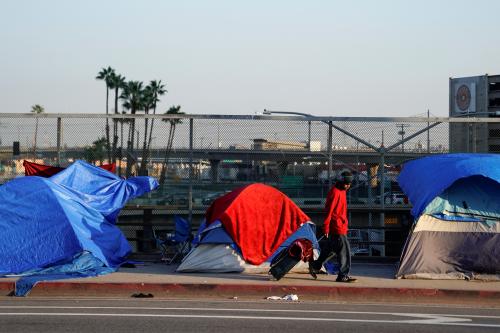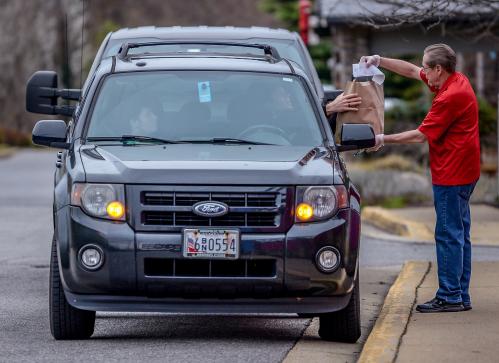Last week, Los Angeles’ mayor shut down all of the city’s farmers markets due to the coronavirus crisis. Two days later, he gave 24 of them approval to reopen with new safety conditions. Seattle’s farmers markets are currently closed, despite the governor declaring them essential businesses. One could say that public sector guidance on farmers markers during the COVID-19 pandemic is mixed, at best.
Across the country, state and local policy on farmers markets is a jumbled patchwork. A dozen states have declared them “essential businesses,” but a majority have not offered concrete guidance on their operation during the crisis, leaving their fate up to shifting guidelines from city and local leaders. This ambiguity puts food-insecure consumers and local farmers in a precarious position, during a time in which access to healthy, affordable food is needed more than ever.
Farmers markets have long served as a way to increase food access in low-income areas, support small farmers and local businesses, and bolster a strong, locally empowering economy. Now, with food insecurity heightened, the agricultural food supply chain at risk, and local economies devastated by businesses closures, farmers markets can fill a critical health and economic gap. But they need federal, state, and local commitment to allow them to remain open and safe as essential services amid the pandemic.
Fulfilling essential health and economic needs
As Project for Public Spaces has written, farmers markets bring healthy options to low-income, food-insecure places and make fresh produce more affordable. Many accept federal nutrition benefits (including SNAP and WIC), and allow low-income families to maximize these benefits through programs such as Double Up Food Bucks, Produce Plus, Market Match, and Market Money. Others also offer health information and critical linkages to health-related services, education programs, and community development organizations.
They serve a vital economic role too, as they support neighborhood revitalization, incubate small businesses who may otherwise lack capital or resources, and offer a uniquely local supply chain that directly benefits local economies. A 2016 study based in California found that farmers who sell directly to consumers generate twice as much economic activity in the region as wholesale farmers, as they are more likely to buy their supplies locally and create local jobs.
Some places are now realizing the importance of these services during crisis, particularly for vulnerable communities. In New York City, the epicenter of the American outbreak, the extensive farmers market system is bringing food to every borough, with new precautions. In places such as Maryland and San Francisco, open markets are acting as the only food source in low-income food deserts.
Farmers markets are holding out as vital distribution channels for local growers too, who are struggling to keep afloat during the pandemic. And while some have raised concerns about social distancing, these markets are putting clear steps in place to ensure they can continue to safely fulfill their food access and economic role.
Adapting to public health realities
The physical aspects of farmers markets may actually make them safer than grocery stores, given their adaptability to shifting public health contexts. Despite serving as gathering places in ordinary times, open-air markets allow for greater social distancing, and temporary booths grant flexibility and enhanced cleaning capabilities. Customers can arrange preorders and pick-ups directly with vendors to avoid standing in lines. And the produce itself is the product of a shortened supply chain, meaning food passes through far fewer hands than in retail outlets.
Farmers market operators around the country are already demonstrating their ability to innovate and develop new best practices, from creating six-foot distancing spaces to inviting local health departments to attend market days for educational outreach. As The New York Times pointed out last week, farmers markets are transforming into “laboratories for new communal safety habits.”
In the short term, this demonstrates that markets—which typically function as a place for community gathering—are adaptable to shifting public health and economic realities. In the long term, this flexibility and innovation will enable them to once again return to their role as holistic sources of community well-being, cohesion, and health for areas that need them the most.
Farmers markets need more support
Despite their potential to meet essential health, food access, and economic needs in an ever-evolving public health crisis, farmers markets are particularly vulnerable right now. As markets adapt their business models to serve areas with high levels of food insecurity, they face a significant loss of income due to market closures, jeopardizing their ability to fulfill this need for long. Market closures are expected to cost small farmers $600 million in lost revenue, and they will hit new and vulnerable farmers the hardest, disrupting local entrepreneurial ecosystems even further.
Farmers markets’ innovation and dedication to their role demonstrate that these public spaces are critical sources of physical and economic well-being, and can lay the foundation for healthy communities now and after the recovery from COVID-19. Yet this pandemic has revealed the fragility of market systems around the country. Many have minimal direct relationships with their state and local governments, and even in ordinary times, there is a significant policy gap when it comes to creating a coordinated citywide or statewide strategy to support this vital health and economic infrastructure.
As farmers markets step in to fulfill essential needs in struggling communities across the country, they need a strong commitment from federal, state, and local leaders to ensure they can stay open safely and that the local networks of growers and vendors remain supported throughout this crisis.







Commentary
Farmers markets are vital during COVID-19, but they need more support
April 8, 2020